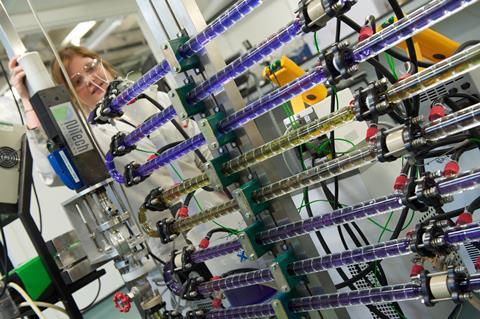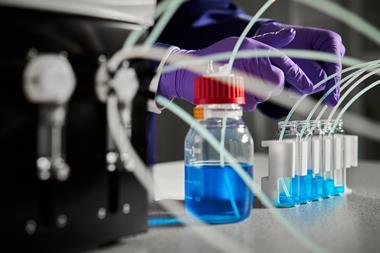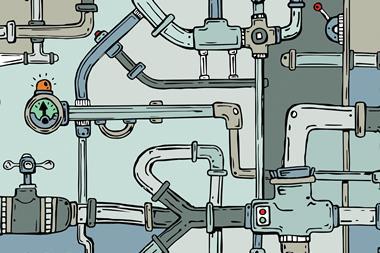Continuous approaches are starting to find use in fine chemicals, as Angeli Mehta discovers
From fine chemicals to pesticides and drugs, chemical manufacturers are rethinking the start–stop batch processing model which has served them for the past 50 years. The drivers are varied: the push for sustainability, improved safety requirements and changing supply chain models are all taking manufacturers in the same direction: towards flow, or continuous, processing.
The industry is no stranger to continuous processing in cases where megatonnes are produced, but for the smaller scale, flow chemistry is offering tangible benefits. The evangelists for this emerging technology point to improved yields, less waste, greater purity of the finished product and, in some cases, a safer process.
‘Safety is the main driver we’re seeing in the past two years,’ says Charlotte Wiles, chief executive of Chemtrix. ‘Where processes are inherently dangerous, [manufacturers] can see a better way.’
But change comes slowly; the chemical industry is conservative and processes don’t change overnight. Chemtrix, which provides training as well as designing and manufacturing flow reactors, finds that the majority of the installations are just 1–3 key steps out of the whole process. ‘Very little is end to end,’ observes Wiles. Her instinct is to identify bottlenecks rather than improving only the reaction, otherwise she finds the problem may just be shunted elsewhere downstream.
The inherent industry conservatism also means there are very few case studies, with companies reluctant to let suppliers reveal details of the work they are doing. ‘A lot of people won’t even tell our chemists what they are using,’ says Anne Kaaden, business chemist and head of marketing for Ehrfeld Mikrotechnik, a flow chemistry company based in Wendelsheim, Germany.
The German company has just been allowed to reveal that its technology has enabled Chinese agrochemicals maker Shaoxing Eastlake Biochemical to run an alkoxylation reaction continuously since last September. 20 batch reactors were replaced with a milli-reactor of just 7.5m in length.
Understanding process
‘The batch paradigm is very good, because whatever you do, you can put into batch – but there can be inter-batch variation, for all sorts of reasons,’ explains Ollie Tames, director of technology at Intensichem, which designs and supplies continuous processing technology. Crucially, batch doesn’t provide optimal processing for every chemistry, as manufacturers have to work within the constraints of the equipment.
In flow chemistry, the reagents are pumped into a small reactor – which can consist of a simple array of channels or a much more complex design – but which crucially allows very efficient mixing. Good heat transfer is achieved because of the high surface to volume ratio, which means reactions can often run at much lower temperatures than in batch. Processes can be scaled up by having multiple reactors in parallel.
If it were to explode, it would be like a burst pipe – compared to a 5000 litre reactor exploding
Net reaction time might only be ten minutes, says Robert Ashe, founder of AM Technology, but in batch, the whole process of cleaning, heating and the subsequent cooling and extraction might take a day. By operating continuously, the same or greater volumes can be achieved, using far less energy. Less material is wasted.
Moving to continuous processing means the size of the reactor can be reduced to such an extent that if it were to explode, the damage could be contained. ‘It wouldn’t be trivial,’ Tames says, ‘but it would be like a burst pipe – compared to a 5000 litre reactor exploding, which might take part of a plant away.’
With continuous you have to sit down and ask “What does this process need?”
‘You’re not using all your raw materials – hold-up volumes are small – and with our technology there shouldn’t be an accident anyway,’ says Wiles. But if something did go wrong, ‘less material would be lost, because unlike batch, it would never be in process all at once’.
The goal is to understand the process more deeply and then pick the appropriate technology for the rate at which you want to manufacture, says Tames. Equipment makers are coalescing around different niches, because the chemistry dictates what type of device is required, says Wiles. ‘With continuous you have to sit down and ask “What does this process need? Does it need high temperature and if so, does it need high pressure to contain the solvent system?”’
Intensichem is working on hydrogenation, continuous melt technology – completely eliminating the solvent for some processes – and oxidation. A smaller plant footprint also means the most appropriate materials can be chosen, for example a corrosion-resistant superalloy such as Hastelloy might otherwise have been prohibitively costly.
Chemtrix tackles hazardous, exothermic, fast or corrosive reactions. It is working on hazardous reactions such as bromination, chlorination, and nitration: ‘The stuff the industry used to farm out to Asia – we’re looking at cleaning it up and bringing it back to Europe,’ Wiles says. Contractors now want work done locally.
Wiles is also seeing a great deal of interest in China, where the government is trying to clean up the chemicals industry through more stringent environmental and safety requirements. The same is true in India, where the generics industry has been rocked by a few high profile concerns about quality in recent years.
All the gear
For small to medium scale, chemical makers now have a lot of choice without having to choose bespoke systems. Some of these are modular and can be reconfigured. Ehrfeld’s plate-based modular system can be used to demonstrate that a process can run continuously in the lab. It can be scaled to full production size with the same structure and channel geometries, using Ehrfeld’s own technology or licensed from others.

UK-based Syrris has just completed an Innovate UK funded project with GSK and the EPSRC Centre for Continuous Manufacturing and Crystallisation (CMAC) which characterised the heat and mass transfer and mixing capabilities of its modular continuous processing system. This will eliminate much of the trial and error for any new application.
Corning has a series of Advanced Flow Reactors which allow a range of chemical reactions such as nitration, oxidation and chlorination, and which can be customised. It recently revealed that one of its reactors is being used successfully by China’s Nanjing refinery for an industrial nitration process, which has reduced the plant’s footprint.
On a larger scale, AM Technology makes general purpose continuous reactors which employ active mixing – loose mixing elements in the reactor body are rotated or shaken, which makes them good at handling different materials such as gas and liquids.
They’re designed for slow reactions such as an enzymatic reaction, or hydrogenation – which is safer to run in flow, because the volume of gas required is dramatically reduced. Ashe says his company’s technology matches the multi-purpose advantage of batch, with the high efficiency of flow. ‘The reality is that chemical manufacturing is a variable business.’ Processes will involve multiple reaction steps, and where different products are being produced at different times of the year, manufacturers can’t afford a different reactor for every job.
The right ideas
Getting the industry interested in adoption means it must have the right skills available. ‘Whenever we take people on,’ we always have to train them ourselves,’ says Ashe. Which makes academic–industrial partnerships like that of CMAC, led by the University of Strathclyde, extremely important.
Its 45 PhD students are getting exposure to industry through projects and mentoring. CMAC also runs an MSc course in advanced pharmaceutical manufacturing, and has staffed a national facilities centre where SMEs can come to carry out research.
The equipment requires a different mindset and discipline to batch, says assistant centre manager Helen Feilden. To learn how to efficiently characterise a new process, CMAC’s students work on a well understood compound – paracetamol – as the basis for workflow experiments. This establishes a discipline because ‘in development work you can hoover through a lot of material and time’. That learning can then be applied to any new drug to rapidly come to an optimised process.
We’ve not had a brand new molecule produced by continuous end to end – yet
The centre focuses its efforts on crystallisation, because this is key to getting a pure substance, explains project manager Stewart Mitchell. This is especially important in pharmaceuticals because a polymorph may cause problems in later processing or storage, not to mention the patient ingesting it. Size matters too: better control over the process in continuous means a narrower particle size distribution. In batch, there would be a mixture, requiring further steps of milling and grinding.
Most of CMAC’s work is with the world’s major pharmaceutical companies, but it has recently worked with Syngenta develop a continuous crystallisation process for the active ingredient of a pesticide. Although not implemented on plant, the learning process led to substantially improved yield and product consistency. It’s also working with a food manufacturer to deliver more flavour with fewer calories.
Pharma exploration
Continuous manufacturing will change how medicines are made. Most of the big name pharmaceutical companies have small teams working on the technology in-house, says Wiles. The feasibility work her company does reflects how busy those teams are, not a lack of expertise.
But flow chemistry means a rethink of infrastructure and the completion of regulatory hurdles. The first explorers have been those producing advanced intermediates for pharmaceutical companies. ‘We’ve not had a brand new molecule produced by continuous end to end – yet. But it will come,’ she predicts.
GSK is currently evaluating the fruits of a $50 million (£40 million) investment to develop a continuous technology for a key API used in respiratory medicines, before it files for FDA approval. The final stages of crystallisation, filtration and drying are still run in batch. Lilly is expected to open a continuous processing facility in Ireland later this year, where it plans to manufacture some small molecule drugs which are in late stage clinical trials.
Crucially, the US Food and Drug Administration (FDA) has thrown its weight behind the transition and is actively exploring the technology. European and Japanese regulators are also evaluating it. Last April, the FDA approved the first switch by a manufacturer from batch to continuous, when Janssen got the green light for one dosage of its HIV treatment, Prezista. Head of continuous manufacturing Mauricio Futran explains they’ve taken the final stages of the manufacturing process from the API to the finished tablet. ‘We’ve confirmed all the benefits we expected: lower investment, smaller footprint and that we can control the quality very well.’ In batch, Futran explains, ‘there is such a disconnection between the early and later steps: when you look at the outcome at the end, there is nothing you can do about what happened at the early part of the process’. Now quality can be constantly monitored – it is designed into the process. Janssen has a products pipeline for continuous processing, says Futran, but it is not yet ready to move the chemistry of its APIs into continuous processing.
The chemical industry hasn’t had a revolution, but one is now underway
The FDA is working with MIT spin-out, Continuus Pharmaceuticals, to build a pilot plant that will enable the regulator to understand the system and to establish a regulatory framework. Continuus licensed the technology which emerged from a 10 year collaboration between MIT and Swiss company Novartis.
Some of Novartis’ $65m investment was directed at building an integrated pilot plant to carry out the last two chemical steps, final salt formation and the formulation of one of its drugs into tablet form. ‘The goal was not so much improvement in yield, but quality; everything that was produced was within spec of anything Novartis had on the market,’ according to process chemist lead, Stephen Born.
The success of the pilot plant demonstrated that it was possible to take a drug with a lead time of six months and reduce it to two days. Novartis, Born recalls, wasn’t expecting it to work so well. Even Bill Gates came to look because the plant was small enough – roughly the size of a shipping container – to offer the potential to make anti-malarials closer to where they’re needed.
Novartis is translating the effort into a state of the art plant in Basel, which will be fully operational in the third quarter of this year in an end-to-end process. Continuus is making technological advances in the US for its clients: improving yield and cutting back on waste by (in one case) continuously distilling the solvent to purify it before recycling it back into the process. Understanding the process of heat and mass transfer is also enabling huge reductions in energy consumption in exothermic reactions – by controlling flow, the heat of the reaction can maintain the reactor vessel at the desired temperature. Such efforts are significant when production is in the thousands of tonnes per year.
Novartis says continuous manufacturing will transform pharmaceutical production. Across the wider chemicals industry, AMT’s Ashe predicts that batch operators will largely move to continuous processing within the next 20 years. ‘The chemical industry hasn’t had a revolution,’ he says, but one is now underway. With reduced costs through ‘energy savings, land use, quality of product […] it seems inevitable that the rush to use flow will come’.
But success, according to Born, will depend on building a team environment across disciplines. ‘You need to integrate skill sets because you can’t find them all in one person – and organisationally that is a challenge.’
Angeli Mehta is a science writer based in Edinburgh, UK













No comments yet